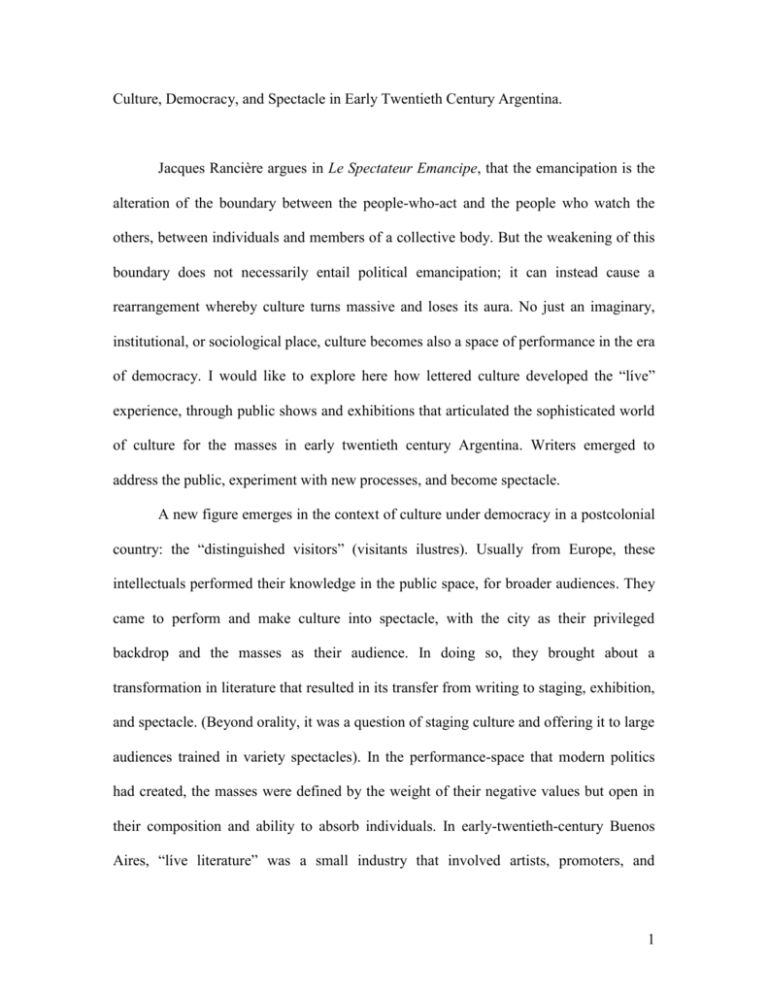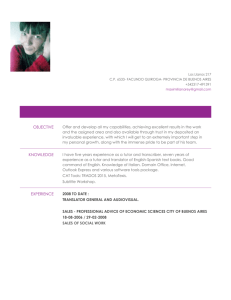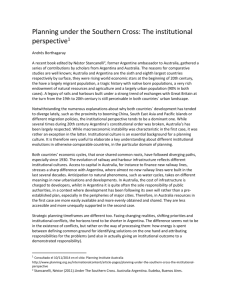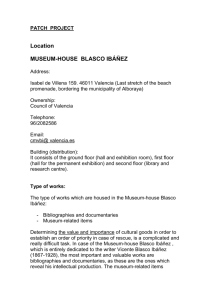Culture__Democracy_
advertisement

Culture, Democracy, and Spectacle in Early Twentieth Century Argentina. Jacques Rancière argues in Le Spectateur Emancipe, that the emancipation is the alteration of the boundary between the people-who-act and the people who watch the others, between individuals and members of a collective body. But the weakening of this boundary does not necessarily entail political emancipation; it can instead cause a rearrangement whereby culture turns massive and loses its aura. No just an imaginary, institutional, or sociological place, culture becomes also a space of performance in the era of democracy. I would like to explore here how lettered culture developed the “líve” experience, through public shows and exhibitions that articulated the sophisticated world of culture for the masses in early twentieth century Argentina. Writers emerged to address the public, experiment with new processes, and become spectacle. A new figure emerges in the context of culture under democracy in a postcolonial country: the “distinguished visitors” (visitants ilustres). Usually from Europe, these intellectuals performed their knowledge in the public space, for broader audiences. They came to perform and make culture into spectacle, with the city as their privileged backdrop and the masses as their audience. In doing so, they brought about a transformation in literature that resulted in its transfer from writing to staging, exhibition, and spectacle. (Beyond orality, it was a question of staging culture and offering it to large audiences trained in variety spectacles). In the performance-space that modern politics had created, the masses were defined by the weight of their negative values but open in their composition and ability to absorb individuals. In early-twentieth-century Buenos Aires, “líve literature” was a small industry that involved artists, promoters, and 1 audiences; it soon developed into an active cultural market in mass society. This industry had a series of emblematic moments: in the 1910s, with the distinguished guests who came for the Centennial celebrations; in the 1920s, with the “friends” of the avant-garde; and later, with the intellectuals invited by Victoria Ocampo and the Sur group. These are the years of the “democratization” of the country: in 1912 Argentina passed the “Saénz Peña Law” which make the vote universal (just for men), secret and mandatory. Under that law the first democratic president of Argentina was elected in 1916 (Hipólito Yrigoyen). I will explore here the links between culture, public spaces and democracy. Among the earliest líve conferences of distinguished visitors, were those organized by Faustino Da Rosa, a Portuguese spectacle promoter known in Brazil, Uruguay, and Argentina (the traditional South American circuit) for staging the first variety shows and revues (with nudity). As Julio Costa recalled in Hojas de mi diario [Pages of My Diary] (1929): “Here Mister Da Rosa began the classic conference, getting Charcot, Amundsen, Margueritte, Enrico Ferri, Blasco Ibáñez, Anatole France, Clemenceau, Jean Jaurés, etc. . . . to come to the Argentinian public forum”. Da Rosa “discovered” the potential of líve performance in cities like Buenos Aires, Rio de Janeiro, and Montevideo, where the public was eager to “meet” artists and intellectuals and watch them perform. Da Rosa convinced intellectuals, many of whom were reluctant, to participate in the new conferences: qtd in Costa 344: “If I ran a large newspaper and I approached you to submit an article under your own name, I think that you would have no reason to refuse. Well I am trying to create a large forum in the American capital that you are visiting, and I am approaching you to participate in it with your masterly words, in a conference”. That is to say, Da Rosa proposed transforming the mediation of writing 2 into the immediacy of the conference. But… spectacle, mass culture’s new social relation, had its own rules; it was not for everyone, especially those who could not stand to come face-to-face with their audience. Costa says: Mister Da Rosa’s conference-program was interrupted after only Monsignor Franceschi, Lugones, and de Tomaso had given their conferences. The others that I have mentioned, including myself, declared ourselves withdrawn, for different reasons, perhaps the most important-one being the excessive size of the Opera Theatre, which required the speaker to raise his voice and speak emphatically, giving a speech rather than having a conversation, as is characteristic of a conference. (Costa 352) Exhibition (of the writer) and anonymity (of the audience) combined to scare these conference participants. Promoters seduced “celebrated artists” with the description of a modern city where culture was becoming an item for mass consumption and the masses participated in the new staging of culture, but mostly they attracted their speakers with the promise of making money. At a moment when all kinds of spectacles were touring the country (from zarzuela companies to opera companies, circus troupes to classical theatre companies, and ballet companies to variety shows and revues), a large and diverse audience began to follow these “cultural acts” as spectacles. The foreign visitors were struck by the number of people who attended these events. The writer Arturo Cancela, in “El cocobacilo de Herrlin” [“Herrlin’s Coccobacillus”, a short story] (from Tres relatos porteños [Three Stories From Buenos Aires], 1923), and La historia funambulesca del profesor Landormy [Professor Landormy’s Tightrope-Walking Story] (published in 1925 as a serial in La Nación, and in 1944 as a book), parodied both the visitors and the natives. Cancela explicitly made fun of the State, the nation’s elites, and the bizarre forms that culture assumed in a country where admiration of Europe was the dominant sentiment. In doing so, he also became one of the first to represent culture as a spectacle, or a good to be consumed by an urban audience. Roberto Gache (writer) was also a critic of the public conference. He says: 3 Haven’t we seen them work before a full audience? It is a rough audience that wants to be entertained, and accepts indifferently the entertainment of a balancing act, a tonadillera (or traditional soloist), a ventriloquist, a piánist, or a conference speaker. At times, they prefer the conference speaker. The cultural institution multiplies the number of conferences, with the aid of an audience that every day contains more women, and is more elegant and more distinguished. (Conferences have acquired a fashionable status.) The conference, in truth, with equal interest to the listener, is less expensive to organize than any other spectacle. Today the discussion is on sunspots; tomorrow, the historical evolution of the hat, then it is labor legislation, fermentation in the digestive system, the rights of nationality, the resistance of steel in housing construction, divorce, international boundaries, industrial uses of lobster, love. . . . More than anything, it is about variation, renovation, not going back to the same thing. Variety—‘la varieté’—is the most complete, most truthful, and most defined spiritual orientation of the moment.] (Gache 1920 133) Gache described a practice turned cultural fashion, criticizing the way that culture had become a good for the public to consume. According to tango historians Binda and Lamas: 131 “At the end of the century’s first decade, a trend or fashion arose that would last for several years: ‘The Conference Speaker.’ They came from any place at all, gave their talk, got paid, and then would write a book about Argentina”. Many of these visitors did indeed write memoirs, testimonies, or notes about their “líve” performances. One such distinguished conference participant was Anatole France, who went to Argentina in 1909, when a promoter hired him for eighty thousand francs to give ten conferences “about whatever he wanted” at the Conservatory of Buenos Aires; he was assured that he could triple his pay by repeating the conferences in Montevideo and 4 Lisbon (stops on his return trip). France traveled with his secretary, Jean-Jacques Brousson, who was to give twelve conferences at the University “about whatever he wanted” for the sum of twelve thousand francs. When France disembarked in preCentennial Buenos Aires, a city where many other distinguished guests were also lining up to do their acts, he had little idea where he was. Brousson, the secretary, wrote a book about this trip following his estrangement from France. He began by mocking Argentina and what “culture” had become in the incipient democratic society: (Brousson 64) “Argentinians are kids. Paying them, they invited our thinkers. They want size them, miserable and depayses, as if they were trained bears or a chimpanzee who plays in the Zoo”. Yet this dependent and backwards country displayed culture’s most modern aspects for the two French intellectuals: consumption and the impact of money on fine art and tradition. Although Brousson, a proud Frenchman, asserted his superiority, he could not see a crucial fact: because he and France had to perform in the new country, they were trapped by its new and radically modern articulations of culture. Before their arrival in Buenos Aires, during a stop in Brazil, France received a letter from Jaime Llavallol, an Argentinian judge who invited Anatole France to stay in his mansion and put his servants at France’s disposal. Although France did not know the judge’s intentions or comprehend the lavishness of this invitation, he was tempted to accept it. Other news arrived from Buenos Aires at the same time; a newspaper declared: (Brousson 185) “The judge who seeks to be a patron has an ambiguous reputation there. He practices sexual heterodoxy. It is hoped that Anatole France will not accept such suspicious hospitality”. But the utterly pragmatic France agreed to stay at the home of the 5 generous judge; it was the only thing he could count-on in an unfamiliar city. The pressure on France continued to mount. While still on the ship, he received a “letter from a ‘group of militant socialists’” who urged him to reject the judge’s hospitality: This bourgeois man is a cruel enemy of the people. On May Labor Day, terrible attacks bloodied the workers’ celebrations. The police tried to break the workers’ ranks. Unable to do so, they took up arms. They shot at the people. There were deaths and injuries, of men but also women and children. . . . They detained large numbers of protestors; ¿would our comrade Anatole France extend his hand toward the bloody hand of the judge who collaborated in this hunt and locked the party elite in prison? That would be a scandal, a betrayal!(Brousson 199-200) France privately protested: (Brousson 200) “What are these people involved in? I did not come to make politics, but literature”. Buenos Aires, and Argentina more broadly, contaminate literature and aesthetics to turn the visitors’ entire reality into politics. France, who did not want to become involved in politics, nonetheless found himself between the militant left and the repressive right. And he did in fact stay in the judge’s house, a house that he scandalously plundered only after rídiculing its ostentatious style. To France, who had not received a dime of his promised salary, it was a game of revenge against the judge who had wanted to bask in the high-culture star’s reflected light. To France, the voyage to South America was a business trip; his purpose was to earn money. He did not prepare his conferences until he was traveling. His secretary described him during a stop in Montevideo: (Brousson 188) “Seated at the lavatory that he converted into a desk, he cuts, pastes, and labels. He is preparing his conferences on Rabelais”, recycling pieces of text that he had published many times. When they arrived in Buenos Aires, the writer and his secretary discovered what it meant to be “líve,” to be 6 present at the site of the performances. But the news is as bad as the weather they experienced; the Conservatory that got Anatole France to come was neither a national institution nor was it official, it was a private enterprise and barely solvent. Since the conservatory’s plan was to pay France with the prófits from ticket sales, the money was not available beforehand. However, France’s conferences—all on Rabelais—attracted almost no audience and generated no prófits. The lack of interest was attributable in part to rumors about France’s selfishness-and-greed that were circulating through the city. His secretary’s conferences at the university were cancelled, and money had to be found to pay him. The timing of the conferences did not help, either. Brousson says: “Competition. Another conference speaker has come to Buenos Aires: Blasco Ibáñez. His arrival has left us with nothing. An immense and delirious crowd gathered to welcome him and escort him to his hotel in triumph”. There is reason to worry: (239) “Blasco Ibáñez’s program also really hurts us. I must admit that his ‘menu’ is richer and more varied than ours”. In the face of this variety, the monotony of Rabelais did not attract the audience that, now schooled in the practice of leisure in the modern city, went to hear conferences in much the same way that it strolled the city’s elegant streets and shopped its commercial avenues; this audience celebrated variety (of color and movement) above all. When the organizers asked France to change his topic from Rabelais to something that could actually attract an audience, the big question arose: What interests the Argentinian people? And the answer: Argentina. France and his secretary got to work: Brousson says 266, “We have spent the entire afternoon working on a conference about Argentina. We have exhausted Baedeker (béideker), geography, the books of Jules Huret. . . . They have yielded very little”. The culture of spectacle required a stage production; 7 being “líve” required paying attention to the audience, building a relationship with the interlocutors that was mediated by market pressures. France remarked spitefully that (274) “With these pre-pubescent people one must get down on all fours and act as a toy”, recognizing the blatant arrival of market forms into traditional culture. If France, who traveled to earn money, thought that Rabelais would light-up the screen of cultural interest, once he was in Buenos Aires, he had to allow the public’s interest to guide his cultural (a)itínerary. When Rabelais did not sell, he had to improvise, and if his conferences were unsuccessful, the judge’s fortune was enormous; the artist retaliated by inviting his lover, a comedic actress, and her entire acting company to líve in the judge’s house. Two separate worlds—those of the distinguished conference speaker and the comedienne-prostitute, who became a mirror of his condition—thus crossed in the judge’s house. Shortly thereafter, France and his secretary fought, and each escaped Buenos Aires on a different ship. France returned to Europe with the comic actors. The country that was unknown, illusory, and deeply problematic turned out to be a place to experience the erasure of the distinction between high and mass culture. Blasco Ibáñez stayed much longer in Argentina. He had been hired by Faustino Da Rosa, manager of the Odeón Theatre in Buenos Aires. The Argentinian journalist Enrique Villareal described Blasco Ibáñez’s arrival to the city: It seemed like a holiday . . . a number of small boats decked out with banners and pennants came out to the edge of the bay to await and accompany the transatlantic liner that transported the distinguished guest. It was ten o’clock in the morning when the steamer came through one of the dams, and as soon as the moorings hit the ground, a cry of jubilation pierced the air. The public reception of Blasco Ibáñez was one of the largest accorded to a distinguished foreigner in Buenos 8 Aires. The crowd accómpanied the writer along his whole journey, and cheers were heard from Spanish people of every region. From the port to the Plaza de Mayo, in front of the Government Palace, the car that carried the novelist almost could not move, so many people crowded the avenue along the Paseo de Julio. As his car arrived at the Plaza de Mayo, the people made way for him, and Blasco felt as if he had been hággd (hugged) by Buenos Aires. (Gascó Contell 104-05) Spanish immigrants in Buenos Aires welcomed the writer; he seduced the Argentinian people and prolonged his stay for nine months, giving conferences throughout Argentina, as well as Paraguay and Chile. Emilio Gascó Contell, a Spanish friend of Blasco Ibáñez who travelled with him, recalled: It is not necessary to say that an oratory tour of such magnitude, carried out under those conditions, lacked any sort of preparation and that the improvisations were more often the virgin product of a fértile imagination. Any topic, local or national, national or international, political or purely artistic, became a passionate speech for those audiences. Blasco himself told me many years later—and with this he confirmed without meaning to the truth in the cruel caricature of old France—that upon arriving to a new city, he consulted the newspapers or the authorities to find the topic they would want him to speak about. They often pointed him toward an issue of local interest. And then, with a few technical readings, a quick briefing was enough for the speaker to go for an hour and a half that same night . . . , without ever boring the audience./ Blasco thus collected ovations and pesos, needing the second far more than the first. (106) 9 Improvisation on local topics was the key to his success. The audience did not come to learn or debate, but rather to hear líve literature and see firsthand how literature talks.1 There was a magic here. If France was sucked into the political issue between the judge and the Socialist Party members, Blasco Ibáñez was trapped by another aspect of Argentina. As he traveled the country, various investors approached him with the idea of buying and developing land for the establishment of a Spanish colony. He agreed, undertaking a colonizing venture that would send him into debt for years. Blasco described this episode: qtd. in Gascó Contell “The dream of becoming a millionaire, even though it was only for a season; the prospect of commanding an army of workers, of transforming the appearance of a corner of the world, of creating habitable places in the desert, were visions too bright for me not to accept the risks of such a gigantic venture”. Imperial dreams… Blasco Ibáñez returned to Madrid, where, from January to June of 1910, he wrote La Argentina y sus grandezas [Argentina and its Splendor]. The illustrated book, more than 700 pages long, was an enthusiastic description of the country. His colonizing venture nonetheless failed. Because he did not understand the country’s changing economic situation, he lost his investment and went into debt. He recovered, however, through literature: in 1916, he published The Four Horsemen of the Apócalypse in Paris. The prologue to the 1923 edition of this novel “on Argentinian topics” relates a conversation between Blasco Ibáñez and French president Raymond Poincaré: Blasco Ibáñez says, “‘I want you to go to the front,’ he told me, ‘but not to write for the The aftereffects of literature talking were felt in writing, according to Emilio Gascó Contell:“But the exclusive preponderance given to the oratory faculties resulted in the momentary atrophy of the talents of the writer. ‘When I returned to Europe,’ says Blasco, ‘I had completely forgotten my craft. In those nine months of discoursing, when I wanted to write something, I had to turn to dictation. And everything that I dictated I did so in a frighteningly declamatory and emphatic tone. . . .’”. 1 10 newspapers. There are many who can do that. Go as a novelist. Observe, and perhaps from your journey will come a book that can serve our cause’”]. The writer, familiar with the value of “líve” experience, took the suggestion and went to the front: (“I never worked in worse conditions. My hands and face were chapped from the cold; I wore the shoes and socks of the soldiers, to suffer less winter’s rigors”). He placed the antiwar propaganda that the French president had requested into the Argentinian countryside, writing about Argentinians who travel to Europe. The novel was a success. Immediately translated into various languages, it was also consecrated in a Hollywood film adaptation that starred Rudolph Valentino, the idol of the moment, who canonized the tango when he danced it for the world. Blasco Ibáñez included a number of Argentinian stereotypes in the novel: the ranchers who squander their fortunes in Europe, the well-to-do boys who dance the tango in Paris, the barbarism of the Argentinian countryside. This commissioned novel, which triumphed in Europe, repeated the images of Argentina put forth by other travelers, including Jules Huret, in the fictional context. Blasco Ibáñez’s book about Argentina was also a compendium of common cliches about the country. Many other distinguished travelers also based their work on Huret’s 1910 La Argentina. De Buenos Aires al Gran Chaco [Argentina: From Buenos Aires to the Gran Chaco]. Enrique Gómez Carrillo, who translated the 1911 Spanish version, later wrote his own “líve” book, El encanto de Buenos Aires [The Charm of Buenos Aires] (1914). Gómez Carrillo was the author of “one hundred books of chronicles” from around the world; each one, including the book about Buenos Aires, privileged writing based on “líve experience.” When he was “líve” in Argentina, Gómez Carrillo did not find the stereotypical Argentinian “rastacuero,” but rather encountered polite, intelligent citizens 11 and beautiful women in a perfect, European-style city. He even wondered: (Gómez Carrillo 265) [“Do I have the disease of finding everything nice?”]. In reality, Gómez Carrillo wrote at the behest of Enrique García Velloso, editor of the daily newspaper La Nación, which published the chronicles that made up the book. As a result, his wholly optimistic in situ experience was aligned with the vision of Argentinian elites: (268) [“Where are the defeated, the unemployed, those who have lost their struggle for life? . . . I don’t see them. And this gives the city an appearance of joy, well-being, and happiness not seen in any other part of the world”. Instead of giving conferences, Gómez Carrillo wrote the optimistic version of Argentina put forth by cultural institutions and civil servants: a country without problems, where even the imperfections of its inhabitants were perfect.2 Another distinguished guest to the city, who traveled to Buenos Aires in person after maintaining a strong symbolic presence there for many years, is Filippo Tomaso Marinetti. His first trip, in 1926, generated suspicion in every cultural sphere: Why did Marinetti go to Buenos Aires? Was he simply an avant-garde poet paying a visit, or another propagandist sent by the fascist regime? Italian theatre promoter Niccolino Viggiani, who lived in Rio de Janeiro, organized his trip. Like Anatole France and Blasco Ibáñez, Marinetti was under contract to conduct a cultural tour, making his conferences part of literature’s most commercial strain. Like those of other distinguished guests, Marinetti’s tour was the subject of daily press coverage. These writers communicated 2 Gómez Carrillo would continue to write in the service of elites: in 1915 he published Campos de batalla y campos de ruinas [Battlefields and Ruins], a book dedicated to Argentinian Minister of the Exterior José Luis Murature. Another antiwar commission, Gómez Carrillo wrote the book at the moment that Argentina felt it needed to justify its neutrality. Like Blasco Ibáñez, he traveled to the front to obtain líve experience of the war. His chronicles managed to see the frivolous side of things, even though the thing in question was a war. Although he did not give conferences in Buenos Aires, he did participate in banquets and cultural acts, and was a regular guest newspaper editor. 12 with “the masses” and the city, but they did so through their performances, not their writing. According to Martín Fierro, the most important magazine of the Argentinian avant-garde: “It has been said that Marinetti comes to these American lands to serve a certain political end. The spirit and orientation of MARTÍN FIERRO lead it to completely reject any insinuation of this nature regarding his already clearly-established activities”. And in the next issue: Regarding Marinetti’s conferences here, and in La Plata, Cordoba, and Rosario, for as much as many have strained to deny it, Marinetti’s mere insistence on proclaiming the beauty of modern life—although this is a truism to us, since we have made such proclamations a practice for many years—is big news to the audience and large newspapers. The avant-garde became the great mediator of modern ideas, an instrument for the massive popularization of aesthetic ideas. Conferences encouraged this popularization. Ramón Gómez de la Serna, the other great idol of the Argentinian avant-guard, did not come to Buenos Aires until 1931, but stayed for years. And there were many others. “Líve” experience meant something different to Gómez Carrillo, for example, than it did to Huret, France, or Blasco Ibáñez; it was also different for José María Vargas Vila, Marinetti, Gómez de la Serna, and the many other distinguished travelers who visited the country.3 And yet, although it served each of them differently, in every case, the líve performance of literature was part of the new relationship between culture and the market, institutions, money, and spectacle in a society that was trying its first democratic experience. Each writer and intellectual gave líve performance a unique form, 3 José María Vargas Vila paid his own way to Argentina in 1924 to challenge Lugones and La Nación. In 1927 he published Odisea Romántica. Diario de Viaje a la República Argentina [Romantic Odyssey: Diary of a Journey to the Argentinian Republic]. 13 building a made-to-measure place, converting space into performance, making literature for the multitudes, and moving from the enclosed space of the book to the lights of the marquee The roots of spectacle lie in urban modernity, a moment when the need to bring unity and identity to the masses led to the creation of large-scale cultural and functional models. In the place within society where the masses perform, the tension between literature, its values, its writers, and its audience was able to develop and neutralize its problematic aspects. Spectacle did something else, too; it allowed the practice of literature to widespread without completely removing the division between high and mass culture. Although letters were symbolically strengthened, lettered practice ceded its space to representation and spectacle. It was in the city that aesthetic space shifted to contain the voice and body of the writer. The ambiguity of “líve” literature demonstrated the transformation of the literary institution under new democratic practice. Along with writers, promoters, and newspapers, the audiences that attended conferences invented new forms for writing culture. Modern reflections on culture and aesthetics tend to examine their political functions. Underlying this question are the new links between art and its consumption in mass society, the re-directing of cultural practices toward the market, and the relationship that develops between these practices and the new audience. I propose viewing cultural practices as phenomena that establish transverse negotiations between different social spheres, from aesthetics to the market, and from variety shows to the conferences given by distinguished visitors to Buenos Aires in the context of a democracy understood as participation and consumerism. 14






